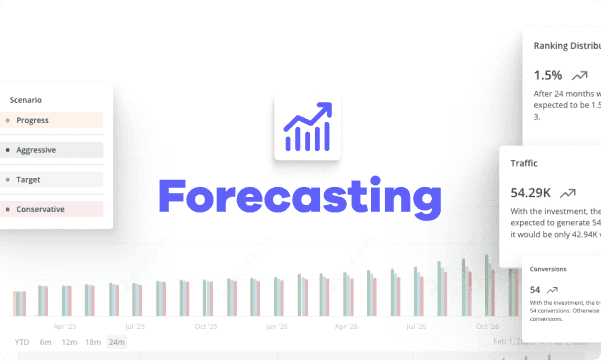8 Best Practices for Monitoring and Interpreting Keyword Position Fluctuations
Last updated on Monday, November 6, 2023

SEO marketers closely monitor movement through Google search engine results pages (SERP) for keywords relevant to their businesses. These fluctuations are the ultimate metric in determining the success or failure of an SEO campaign.
It’s one thing to check periodically to see if you’ve gone up or down in the rankings. But if you don’t understand why fluctuations occur, you won’t be able to correct mistakes or double down on what’s working.
In this article, we’ll explore why fluctuations occur on popular search engines like Google. Then, we’ll offer eight best practices to help you accurately track search query movement and interpret what these fluctuations are telling you.
Understanding keyword position fluctuations
When we talk about keyword position fluctuations, it refers to the movement of your links up and down the SERP.
These fluctuations can be positive, moving you up in the rankings toward the coveted first page for a search query, or they can be negative.
Unfavorable fluctuations move you down in the rankings and can be overcome by understanding why this movement occurred. So, that begs the question, what causes keyword position fluctuations?
There are several reasons keywords might fluctuate negatively, including:
Google search algorithm changes: Google periodically changes its search algorithm to serve its audience better. While focusing on a hot search engine optimization trend might have served you well at one point, that can all change following one algorithm shift.
Search penalization: Google penalizes websites that break its rules and use black hat SEO tactics. For instance, creating fake backlinks from mannequin sites is an example of something Google would penalize you for.
Competitor actions: Your competitors do the same SEO work, and their efforts can unseat you. If one of your competitors makes a strong SEO push, it could move you down the SERP as they take your place.
8 keyword fluctuation best practices
Now that you understand keyword fluctuation and the factors that influence it, let’s discuss eight best practices. These tactics can help you accurately and effectively monitor and interpret this movement.
#1. Choosing the right keywords to monitor
One of the first things to remember is that you can’t target every keyword associated with your industry.
Instead, focus on an elite selection of relevant search terms that meet two critical criteria:
High monthly search volume
Low competition (low keyword difficulty)
Sure, you could target some of the biggest and most searched-for terms on the Web, but doing so puts you at an extreme disadvantage. If the term has high competition with big-name entities, it will be an uphill battle you might never win.
For example, if you’re a travel agency, you might want to rank for the term “Walt Disney World vacations.” Disney is one of the most popular vacation destinations on the planet, so a good page one placement for that search query would be huge for your business.
There’s just one problem — it’s a hotly contested term.

Source: Google In the image above, you can see the top of the first page. First, you have the official Disney page, followed by Costco, Southwest Airlines, and Expedia. These global enterprise organizations will be all but impossible to beat for top spots.
Don’t forget about search volume.
If a term has next to no competition but also an incredibly low search volume, ranking for it won’t do your business much good.
#2. Importance of targeting relevant keywords
The keywords you target need to be relevant to your business. This is essential both for Google and your audience targeting efforts.
Google wants to make sure that the top search query results are authoritative voices in that niche. Simply listing a bunch of keywords and establishing some links isn’t going to cut it. Google will test both the quality of your content and your authority on a given subject. On top of that, understanding and incorporating effective writing habits is key to establishing authority in your niche and ensuring your content rises to the top of search engine results pages (SERPs).
So, if you’re a company selling water filters and trying to rank for terms related to overall kitchen renovation, Google won’t give you a lot of attention. But by proving yourself as an authority in water filters and targeting terms associated with them directly, you can make a much stronger case.
Additionally, targeting irrelevant keywords is counter-productive. Even if you managed to rank for them, you’d bring in searchers who aren’t interested in what you offer. The result would be an increased bounce rate, which can cause negative keyword position fluctuations.
#3. Setting an appropriate monitoring frequency
It’s important to monitor your keyword fluctuations regularly. Set up regular monitoring intervals and stick to it.
At a minimum, you should be checking keyword positions once a week. When Google makes major changes, it can often take a few weeks to see movement. But simply checking your rankings once a month isn’t going to cut it.
Ideally, you should be checking your rankings daily. This frequency will help you determine your average position over time so you can get a better idea of what kind of movement is normal.
#4. Using advanced rank tracking features
When checking your rankings daily, it’s better to trust in a quality tool that can do tedious research for you. That makes these daily checks a simple matter that won’t eat up valuable time.
For instance, AccuRanker provides daily on-demand updates on your SERP rankings. It generates an in-depth report that shows your search rank history along with insights that can help you make data-driven decisions to improve your SEO strategy.
Source: Accuranker
The best part?
With AccuRanker, you’re not limited in how often you can track rank changes. The system works nonstop, and can provide updates whenever you need them.
#5. Setting baselines and benchmarks
When trying to interpret keyword fluctuations, it’s important to have a point of reference. That’s why each keyword you target needs baselines and benchmarks. These goals and minimum performance requirements will help you determine whether you’re meeting or exceeding expectations.
When setting any goal, make sure to use the SMART system. SMART is an acronym that stands for:
- Specific
- Measurable
- Achievable
- Relevant
Time-bound
It’s important to set achievable benchmarks based off data. How much competition do these terms have? What’s the average level of movement you’re seeing? Keep that in mind when setting goals.
#6. Evaluating the impact of SEO changes
When SEO changes happen, it can be exciting and terrifying. But it’s important to keep your cool and evaluate these changes' impact on your business.
For example, if you achieved page one penetration on a high-value term, how has that impacted your website traffic and conversions?
If you see positive movement but no real change in your bottom line, that could indicate an issue on your site. Maybe you've attracted the wrong crowd or something about your layout is driving people away.
Turning to tools like session replays and heat maps can help in this regard.
Source: Smartlook
These tools can show user behaviors on your site and identify performance issues. You can then make the necessary changes fast.
#7. Analyzing competitor movements
Competitors are all gunning for the same goals as you. But there can only be one number-one ranked site on a SERP. That’s why it’s important to keep track of your competitors and determine what they’re doing right and wrong. Then, figure out how you can counteract their efforts.
This is another area where a quality rank monitoring tool comes into play.
Source: Accuranker
In the image above, you’ll see that AccuRanker provides tracking information on major competitors. This allows you to identify threats and adjust your strategy accordingly. AccuRanker can track each competitor's voice share, gauging what percentage of user attention all of your rivals have.
Share of voice is a metric that takes each competitor's average click-through rate and compares it to the overall search volume for the term.
It also tracks ranking distributions, creating graphs that show your performance in these areas compared to competitors.
#8. Considering seasonality and industry trends
Keep in mind that the seasons and trends of your specific industry can cause shifts in search volume that could ultimately impact your bottom line.
For example, in our fictional travel agency example above, the search volume for relevant terms will likely increase as the summer approaches and families start planning vacations. So, part of your SEO strategy could be achieving page-one penetration on the SERP for relevant terms by the start of your busy season.
It’s also important to keep trends in mind. For example, right after the Covid pandemic, vacationers weren’t interested in cruise vacations. But in 2023, we’re seeing a rise in cruise vacations, marking a new trend that businesses in this industry should note.
To this point, now that cruises are popular again, travel agencies (like our example) should start focusing on cruise-related key terms.
Conclusion
SERP rankings are constantly shifting. If your SEO strategy is going to succeed, you’ll need to keep a close eye on these fluctuations and know how to capitalize on them.
By sticking to the eight best practices listed above, you can gain tremendous data-driven insights into your SEO plan and make smart changes that can keep your keyword positions trending upward.
PS: Don’t forget to give AccuRanker a try. We currently have a 14-day free trial so you can put these insights into action. ☑️
That’s it for now, SEOs.
Here’s to your success!

Article by:
Catalina Grigoriev
SEO and Content Marketing at Planable
Catalina Grigoriev is a incurable optimist with a bubbly personality. That’s what my colleagues say. Secret mission: cat lover disguised as a dog person. Ex law student who switched into the digital marketing lane. Currently delving into the depths of SEO and content marketing at Planable.


